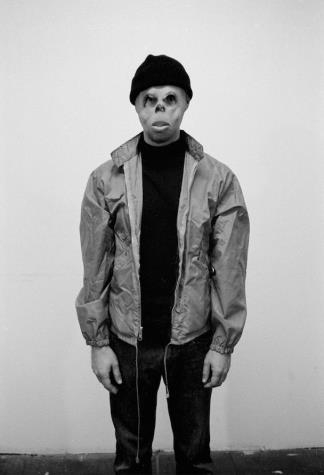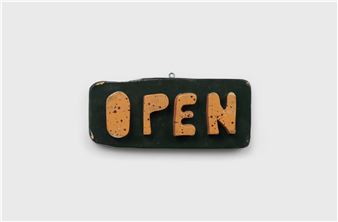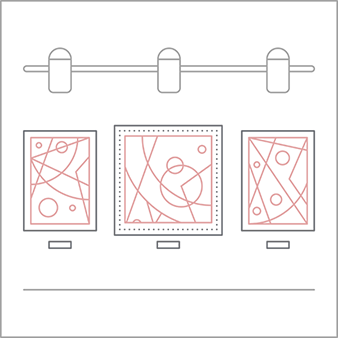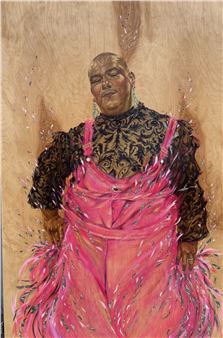Omul Negru
It‚Äôs an election year in the United States of America. For which Boogeyman will you vote? This is not a provincial issue. The world is in the balance. The people of America will be divided on a level that civil uprising will never solve. Our lives are hurtling ever closer to democracy‚Äôs glass ceiling, naiŐąve to the ominous reset on the other side. Never has our democracy been so readied for a tyrannical awakening. Big Brother, Donald Trump, or Artificial Intelligence all loom above, ready to take over.
We are religiously superstitious. Behavior, social mores, architecture, time and culture are all negotiated to some degree by superstition that we’ve lost or assimilated to the point of forgetting. All superstitious ritual has either the function to ward off evil or bring good luck, both semantic turns from darkness. Death and its harbingers are the predominant force lurking in those shadows. Despite our intense culture of logic, even the most atheistic person becomes agnostic when confronted with evil.
Hollywood and folklore have offered us a storytelling culture that repeats the same fables with different characters. The intensity of the path surrounded by evil is ever-present and varies in each specific tale. It is a constant reminder not to go there. There are dragons beyond.
The Boogeyman remains a generous constant in universal language and symbolism. Determining the face of potential evil is one of the Boogeyman‚Äôs most elusive and valued qualities. It serves as a flexible means for keeping the victim in a state of fear. By lacking a clear face or identity, it is the perfect portrait for all irrational fears - an adaptably direct personification of pure evil. This cultural production is called ‚ÄúOmul Negru‚ÄĚ, Romanian for ‚ÄúThe man in black‚ÄĚ or ‚ÄúThe black man.‚ÄĚ
Spanning forty artworks, Omul Negru is an anthropological occurrence, one comprised of both cultural enactment and ritual embodiment, invoked to explore the varied notions of the Boogeyman. It is a celebration of civilization’s most important character, a figure that has transcended in the 21st Century into a monster of ever-expanding applications. This spectrum of visual culture’s darkest corner is traced through artists, martyrs, serial killers, madmen, and monsters; to explore the many faces as well as the facelessness of the Boogeyman. It traverses the origins, stereotypologies and embodiments of the Boogeyman through contemporary, historical, and archetypal lenses - staging an ominous atmosphere of summoning and possession.

Recommended for you
It‚Äôs an election year in the United States of America. For which Boogeyman will you vote? This is not a provincial issue. The world is in the balance. The people of America will be divided on a level that civil uprising will never solve. Our lives are hurtling ever closer to democracy‚Äôs glass ceiling, naiŐąve to the ominous reset on the other side. Never has our democracy been so readied for a tyrannical awakening. Big Brother, Donald Trump, or Artificial Intelligence all loom above, ready to take over.
We are religiously superstitious. Behavior, social mores, architecture, time and culture are all negotiated to some degree by superstition that we’ve lost or assimilated to the point of forgetting. All superstitious ritual has either the function to ward off evil or bring good luck, both semantic turns from darkness. Death and its harbingers are the predominant force lurking in those shadows. Despite our intense culture of logic, even the most atheistic person becomes agnostic when confronted with evil.
Hollywood and folklore have offered us a storytelling culture that repeats the same fables with different characters. The intensity of the path surrounded by evil is ever-present and varies in each specific tale. It is a constant reminder not to go there. There are dragons beyond.
The Boogeyman remains a generous constant in universal language and symbolism. Determining the face of potential evil is one of the Boogeyman‚Äôs most elusive and valued qualities. It serves as a flexible means for keeping the victim in a state of fear. By lacking a clear face or identity, it is the perfect portrait for all irrational fears - an adaptably direct personification of pure evil. This cultural production is called ‚ÄúOmul Negru‚ÄĚ, Romanian for ‚ÄúThe man in black‚ÄĚ or ‚ÄúThe black man.‚ÄĚ
Spanning forty artworks, Omul Negru is an anthropological occurrence, one comprised of both cultural enactment and ritual embodiment, invoked to explore the varied notions of the Boogeyman. It is a celebration of civilization’s most important character, a figure that has transcended in the 21st Century into a monster of ever-expanding applications. This spectrum of visual culture’s darkest corner is traced through artists, martyrs, serial killers, madmen, and monsters; to explore the many faces as well as the facelessness of the Boogeyman. It traverses the origins, stereotypologies and embodiments of the Boogeyman through contemporary, historical, and archetypal lenses - staging an ominous atmosphere of summoning and possession.
Artists on show
- Adrian Ghenie
- Alban Muja
- Ana Prvacki
- Asger Kali Mason Ravnkilde Moulton
- Benja Sachau
- Bob Flanagan
- Brian Butler
- Brock Enright
- Ciprian Muresan
- Damien Echols
- Daniel Albrigo
- Daniel Keller
- Douglas Gordon
- Ecaterina Vrana
- Ed Gein
- Genesis Breyer P-Orridge
- Günter Brus
- Hamid Piccardo
- Jamian Juliano-Villani
- Jim Jones
- John Duncan
- John Houck
- John Wayne Gacy
- Jon Rafman
- Lionel Maunz
- Marco Lavagetto
- Max Hooper Schneider
- Mike Bouchet
- Mike Kelley
- Richard Serra
- Robert Therrien
- Sheree Rose
- Sterling Ruby
- Steven Parrino
- Ted Kaczynski
- Will Boone
- Zhou Yilun
Contact details


 ARTISTS
ARTISTS















